A shaky future for U.S. transit systems, and why we need to save them
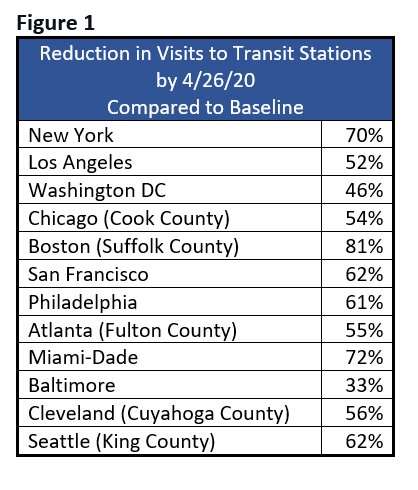
COVID-19 and the lockdown of cities have severely impacted transit systems around the world. With people working and studying from home, demand for transit has plunged to unprecedented levels. In pandemic times, transit systems have become hazardous places where the virus can easily spread. So far more than 100 transit workers in U.S. cities have succumbed to coronavirus.
To contain the virus, protect riders and workers, and adjust to lower demand, transit agencies have shut down systems partially and intensified cleaning and disinfecting operations of trains and buses. Despite deep cleaning efforts, transit is not a desirable option. In major cities, many companies have stepped up to provide free or highly discounted transportation alternatives to essential workers—the only commuters left these days. It is not a surprise that bicycle rides are on the rise. Bike counters outside Philadelphia recorded a 471% spike in cyclists on Kelly drive, a road that, in regular times, is used by suburban car commuters avoiding the highway.
Before COVID-19, transit agencies across the U.S. had experienced the fierce competition of ride-hailing. Ridership was already in a downward trend since 2014, especially for transit buses in the largest cities.
After a partial or full re-opening of the economy, the prospect for transit agencies to return to "business as usual" doesn't look good. The oil glut coupled with historically low prices at the pump have the potential to increase car travel and lower Uber and Lyft fares. Though that potential may not be realized if massive unemployment levels persist and fewer people are able to afford cars or Uber services. That was the case in the last recession when transit ridership bounced back after 2008. This time, a rebound would be challenging due to the competition of ride-hailing services (non-existent in 2008) and micro-mobility options, as well as the stigma of transit stations and vehicles being places of contagion. Buses and trains are likely to operate semi-empty until people get vaccinated or cases are reduced to a minimum.
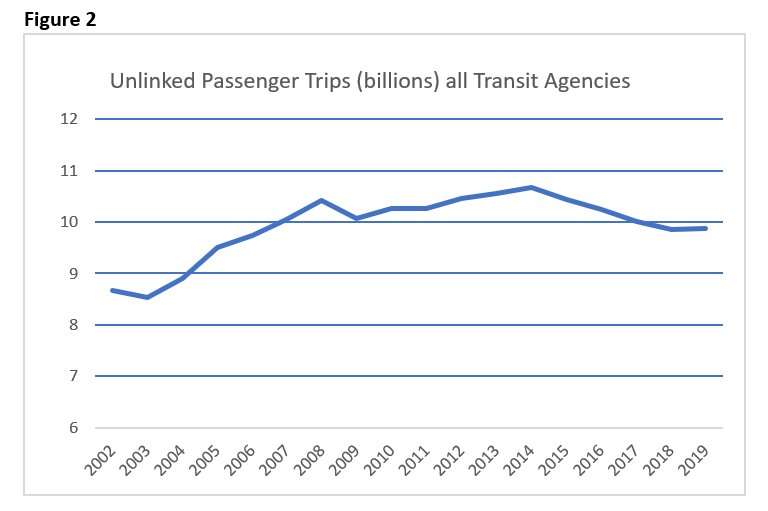
From a financial perspective, the situation is also grim. Not only have fare revenues plummeted, but state and municipal budgets—the primary funding sources for public transportation in the U.S.—are severely strained by lower tax revenues and increased demands (e.g. unemployment insurance and Medicaid coverage) for limited funding. While most of the agencies have curtailed services resulting in some operational savings, the cleaning and disinfection of trains and stations are now priorities that could substantially impact transit agencies' budgets.
To avoid the complete shutdown of transit in many cities, the stimulus package (CARES Act) included $25 billion to transit agencies. The package and some additional funds coming from the Public Transportation Emergency Relief Program represent more than 30% of the total revenues of transit agencies (Figure 4) in 2018 . Although these resources will allow agencies to offset the lost revenues from fares, the decrease from local and state sources could be substantial.
All of this comes at a time when transit is playing an increasingly critical role in the energy transition. With the potential to be a cleaner alternative to the car, it can reduce the dependency on fossil fuels and contribute to the reduction of emissions and congestion in cities. At the same time, transit makes cities sustainable and equitable as it provides an affordable transportation option and access to places for everyone, especially the poorest.
-
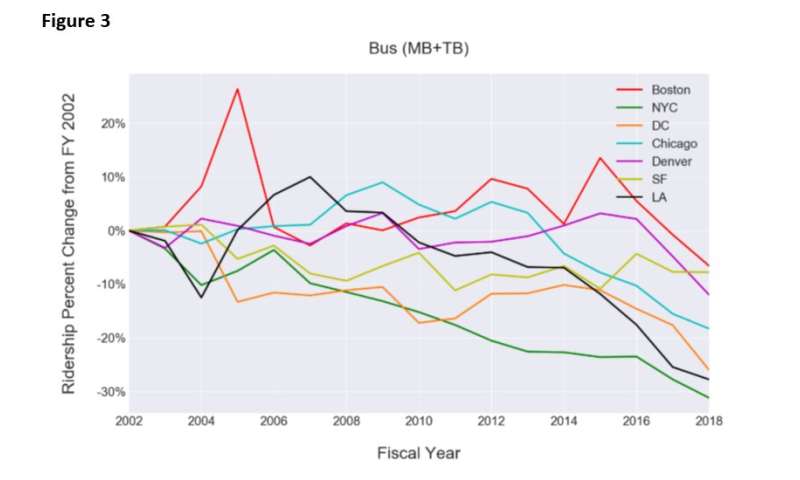
Credit: Edhardt, Graehler and Mucci (2019) -
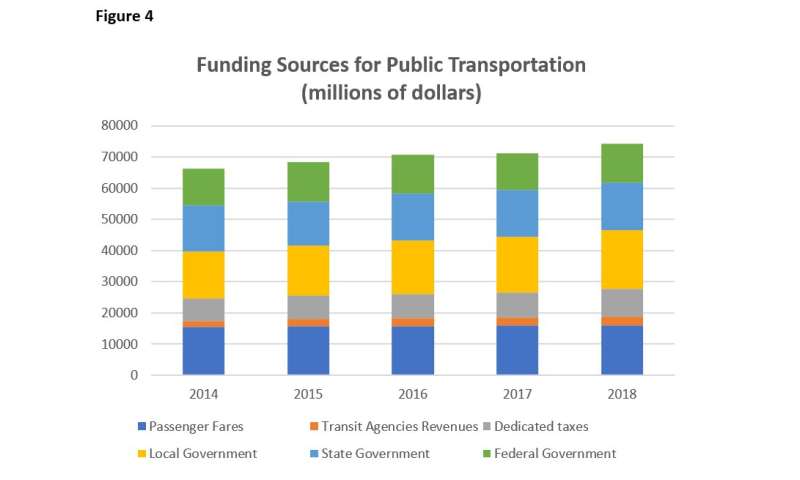
Credit: 2020 Public Transportation Fact Book Appendix A table 95 -
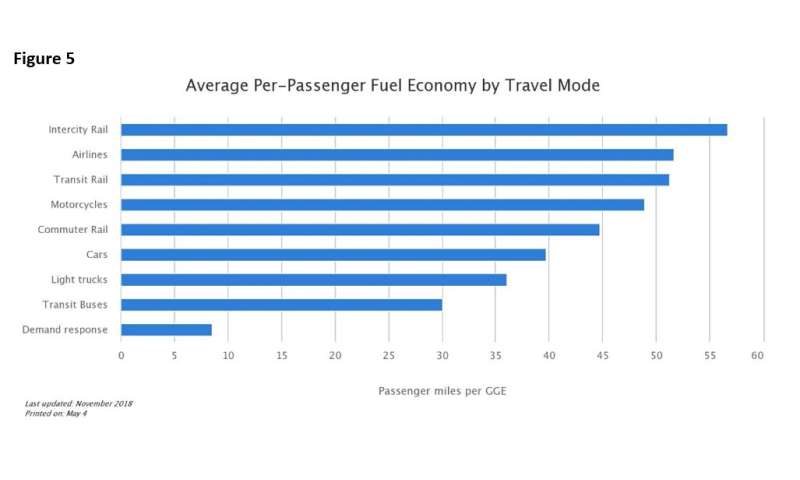
Credit: Oak Ridge National Laboratory Table 2.14 of the Transportation Energy Data Book 36B. 2018. Ridership rates of transit buses is less than 25%.
While the pandemic has demonstrated how vulnerable transit systems in the United States are, there are opportunities to increase resiliency. Increasing funding is the first step, as transit agencies will need to operate with a reduced ridership while continuing to offer an affordable service. Operational changes will be also required to adapt to the new normal.
This transformation must keep in mind the environment. Unlike trains, transit buses running with few passengers have lower fuel efficiency and therefore generate more emissions per passenger than cars (Figure 5). Despite the financial pressure to cut expenditures, ongoing efforts to update routes and better integrate different travel modes to attract riders should continue. A new stimulus package must allow for the funding of green investments to complete the electrification of transit bus fleets around the country. When deciding whether to give additional relief to transit agencies, lawmakers must keep perspective: the airline sector received $50 billion in the first stimulus package. In that context, how much do we value the service public transit provides? Decision-makers must also consider that transit in the US will be the only travel mode for the poorest among us, a population that cannot afford to live near their workplaces to cycle or walk, and also a population that is increasing sharply with the pandemic.
The future of transit agencies is in peril. It's time to value public services for all the good they do.
More information: Understanding the Recent Transit Ridership Decline in Major US Cities: Service Cuts or Emerging Modes? www.researchgate.net/publicati … ts_or_Emerging_Modes


















